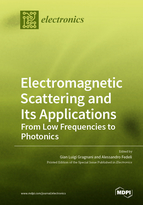Electromagnetic Scattering and Its Applications: From Low Frequencies to Photonics
A special issue of Electronics (ISSN 2079-9292). This special issue belongs to the section "Microwave and Wireless Communications".
Deadline for manuscript submissions: closed (31 August 2021) | Viewed by 17995
Special Issue Editors
Interests: electromagnetic scattering; electromagnetic compatibility; antenna design; bioelectromagnetics; open-source codes
Special Issues, Collections and Topics in MDPI journals
Interests: forward and inverse electromagnetic scattering; computational electromagnetics; microwave imaging
Special Issues, Collections and Topics in MDPI journals
Special Issue Information
Dear Colleagues,
Few research topics are as broad and pervasive as electromagnetic scattering. Undeniably, electromagnetic scattering phenomena are behind many wireless and radio devices. From radar systems to mobile telecommunications, from medical devices to innovative materials, the study of electromagnetic interactions and scattering is fundamental to develop applications that exploit electromagnetic waves.Although the initial research in the field dates back centuries ago, many unresolved theoretical issues are still there. At the same time, novel applications of electromagnetic scattering are continuously emerging. A detailed description of the many areas in which scattering is involved is well beyond the scope of this short summary. Based on the wavelength, applications may be very different, as well as the techniques used to analyze and simulate the electromagnetic propagation. Starting from low-frequency problems and embracing the whole spectrum up to optics and photonics, the goal of this Special Issue is to provide a comprehensive collection of state-of-the-art papers dedicated to electromagnetic scattering theory and applications.Therefore, we invite qualified scientists in this field to submit their valuable contributions to this Special Issue. Original research works, as well as tutorials and review papers, are welcome. Topics include, but are not limited to the following:
- Electromagnetic scattering theory
- Numerical and computational techniques (e.g., simulation methods, open-source codes)
- Inverse scattering and remote sensing
- Electromagnetic scattering and information theory
- Scattering effects originated by different kinds of targets and situations (e.g., scattering by canonical objects, complex structures, moving obstacles; scattering by innovative materials and nanoparticles; Raman scattering and plasmonic effects)
- Scattering measurements and applications in civil, industrial, and medical frameworks (e.g., energy harvesting, cloaking, radar, antennas, and next-generation telecommunications)
- Future perspectives and unconventional applications
Prof. Gian Luigi Gragnani
Dr. Alessandro Fedeli
Guest Editors
Manuscript Submission Information
Manuscripts should be submitted online at www.mdpi.com by registering and logging in to this website. Once you are registered, click here to go to the submission form. Manuscripts can be submitted until the deadline. All submissions that pass pre-check are peer-reviewed. Accepted papers will be published continuously in the journal (as soon as accepted) and will be listed together on the special issue website. Research articles, review articles as well as short communications are invited. For planned papers, a title and short abstract (about 100 words) can be sent to the Editorial Office for announcement on this website.
Submitted manuscripts should not have been published previously, nor be under consideration for publication elsewhere (except conference proceedings papers). All manuscripts are thoroughly refereed through a single-blind peer-review process. A guide for authors and other relevant information for submission of manuscripts is available on the Instructions for Authors page. Electronics is an international peer-reviewed open access semimonthly journal published by MDPI.
Please visit the Instructions for Authors page before submitting a manuscript. The Article Processing Charge (APC) for publication in this open access journal is 2400 CHF (Swiss Francs). Submitted papers should be well formatted and use good English. Authors may use MDPI's English editing service prior to publication or during author revisions.
Keywords
- Electromagnetic scattering theory
- Analytical and numerical methods
- Computer codes
- Inverse scattering and remote sensing
- Information theory and scattering
- Innovative materials and nanoparticles
- Electromagnetic cloaking
- Electromagnetic energy harvesting
- Next-generation telecommunications
- Medical and industrial application







